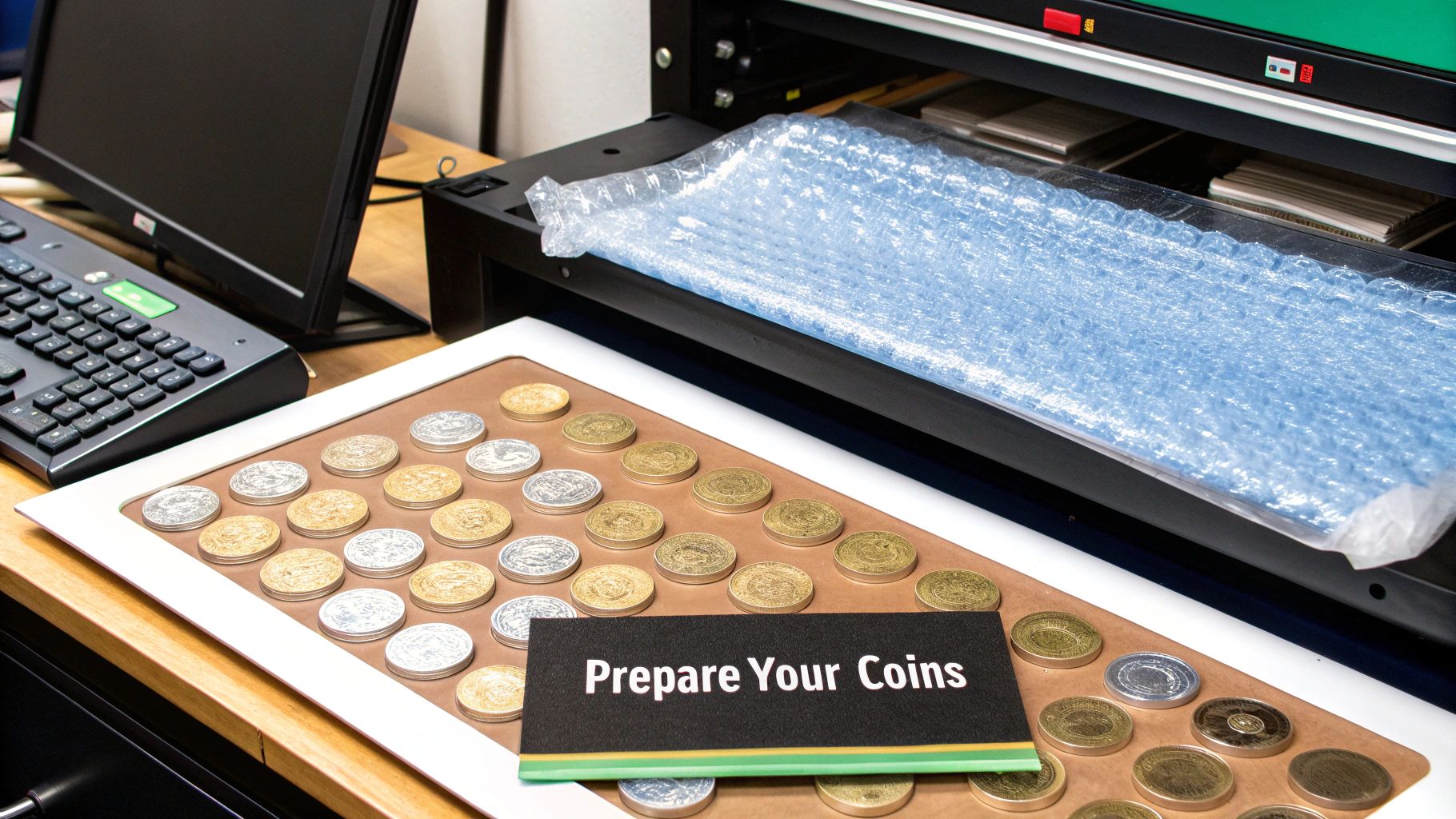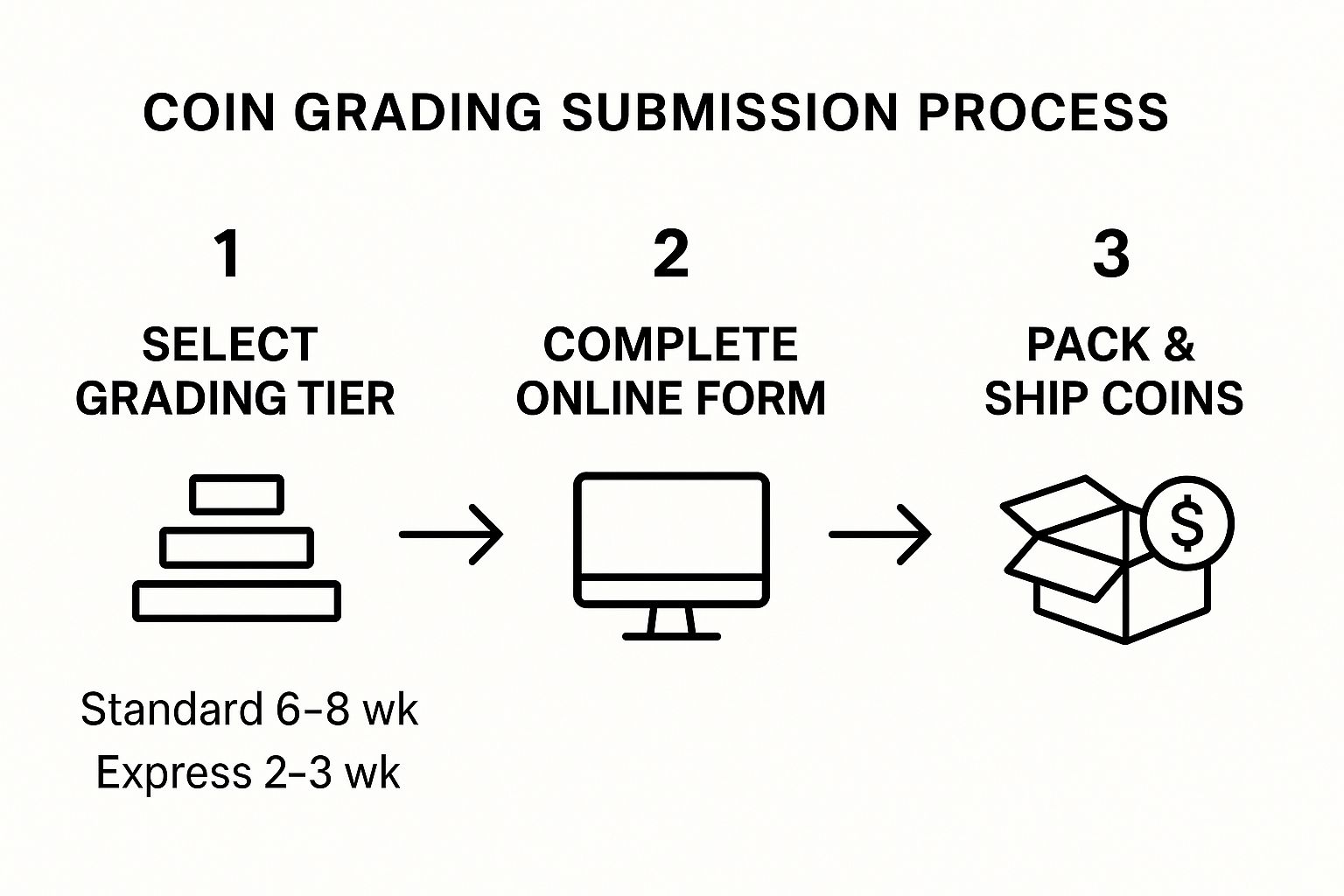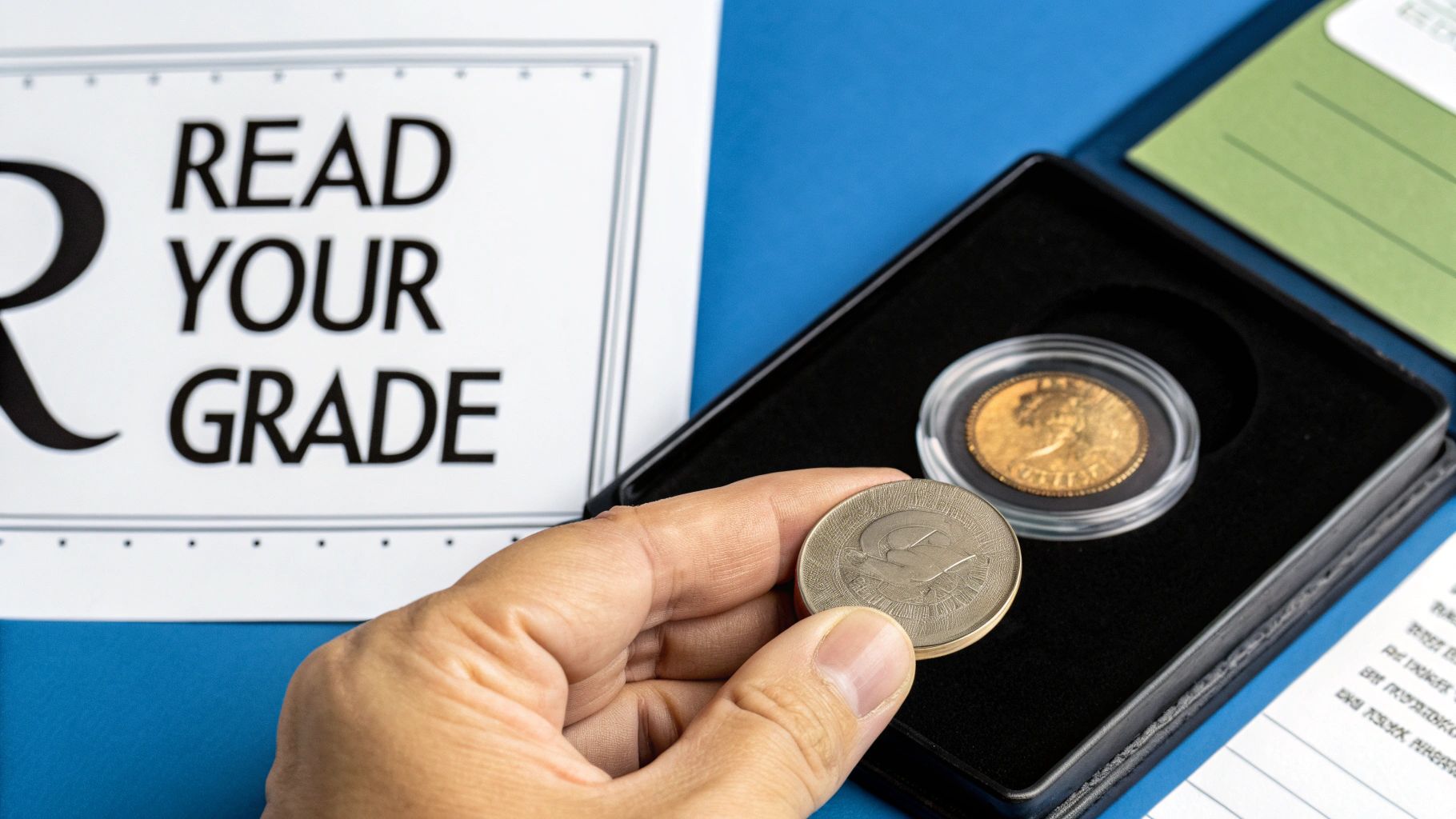Thinking about getting your coins professionally graded? It's a straightforward process where you send them off to a trusted third-party service, like PCGS or NGC. They'll meticulously assess your coin's authenticity and condition, assigning it a specific grade before sealing it in a secure, protective slab. This official certification is what truly verifies a coin's value and makes it a trusted asset in the market.
Why Professional Coin Grading Matters for UK Collectors
Before we get into the nuts and bolts of how to submit your coins, it’s worth taking a moment to understand why this is such a critical step for any serious collector. Professional grading goes far beyond a simple "it looks new" assessment. It provides an objective, standardised evaluation of your coin's quality that is respected by collectors and dealers across the globe.
For those of us collecting in the UK, this is huge. It effectively turns a raw coin into a liquid asset, bridging the gap between our traditional British grading terms and the international standards that drive the market.
The Five Pillars of UK Coin Grading
Here in the UK, a coin's final grade isn't just a number pulled out of thin air. It’s the result of a careful evaluation based on five key characteristics. Together, they tell the full story of a coin's journey, from the moment it was struck to how it looks today.
- Strike: This is all about the initial quality of the minting. A sharp, full strike means you'll see every crisp detail just as the original designer intended.
- Condition: This refers to the wear and tear a coin has picked up since it left the mint and entered circulation.
- Lustre: Think of this as the original 'shine' or 'frost' on a coin's surface, straight from the minting press.
- Colour: This refers to the coin's toning or patina. It can be a beautiful, natural process that adds character, or it can be a sign of environmental damage.
- Eye Appeal: A slightly more subjective factor, but absolutely crucial. It’s the overall visual attractiveness of the coin. Does it just 'pop'?
These elements combined are what separate a prime, top-tier example from just another piece of metal.
UK vs International Grading Systems
One of the biggest points of confusion for many collectors in the UK is the difference between grading systems. We've traditionally used descriptive terms like 'Fine' (F), 'Very Fine' (VF), and 'Extremely Fine' (EF). While these are useful, they can be subjective and leave a lot of room for interpretation.
The international market, on the other hand, is dominated by US-based services that use the Sheldon scale. This system assigns a numerical grade from 1 to 70, offering a much finer degree of precision, especially at the high end for uncirculated coins. As you can see in our guide to the European coin grading system, getting to grips with both systems is essential if you want to navigate the global marketplace successfully.
The Sheldon scale's granularity has a massive impact on value. A jump from an MS-64 (Mint State 64) to an MS-65 can result in a price difference as large as tenfold for the exact same coin.
This is precisely why getting a professional opinion is so valuable. An expert, third-party grader removes the guesswork, confirms your coin is genuine, and assigns a grade that has clear meaning and value in both the UK and international arenas. As noted by Coincraft, while some UK experts have argued for simpler uncirculated categories, it’s the fine distinctions of the numerical system that truly dictate market prices and collector demand today. You can read more about the intricacies of UK coin grading on Coincraft.com.
Choosing the Right Coin Grading Service in the UK

Picking a grading service is probably one of the biggest calls you'll make as a collector. It's a decision that goes far beyond just getting a grade on a label; it directly impacts your coin's perceived value, its authenticity, and how easily you can sell it. You're essentially choosing between global recognition and specialised local knowledge.
The coin grading world has two undisputed heavyweights, both based in the US: the Professional Coin Grading Service (PCGS) and the Numismatic Guaranty Company (NGC). These names are the gold standard globally. A coin in one of their slabs is trusted almost anywhere in the world, giving you instant liquidity in the international market.
If you have a particularly valuable world coin, or even a British coin with wide international appeal, going with PCGS or NGC is usually the smartest move. Their reputations are built on decades of consistency, so their grades are seen as the benchmark. This is absolutely vital if you're thinking of selling at an international auction or to dealers outside the UK. Just be prepared for the logistics of sending valuable items overseas—it means dealing with international shipping, customs forms, and often, longer waiting times.
Balancing Global Reach with Local Expertise
But what if your collection is focused squarely on British coins? This is where UK-based services come into their own. They can offer a deeper, more nuanced understanding of British varieties, especially modern rarities that an international grader might not fully appreciate.
A good example is the London Coin Grading Service (LCGS). They do things a bit differently, using a 100-point scale which they argue better captures the fine details of UK coinage and helps avoid the grade inflation sometimes seen elsewhere. While this approach is respected within the UK, you have to be realistic. An LCGS slab just doesn't have the immediate commercial clout of an NGC or PCGS holder on the world stage. It's a critical trade-off to consider. You can dive deeper into this UK-centric grading philosophy at The Coinery.
Ultimately, it all boils down to what you plan to do with the coin. If you're chasing maximum global liquidity and value, PCGS or NGC is the way to go. If your collection is purely for British interest, a UK service might give you a more detailed and cost-effective result.
To help you decide, think about these key points:
- Market Trust: Who is your likely buyer? The answer will tell you which slab they will trust the most.
- Grading Consistency: PCGS and NGC have built their entire brands on being reliable and consistent over many years.
- Holder (Slab) Quality: All the top services use high-quality, sonically sealed, and tamper-evident holders to protect your coin for decades to come.
- Turnaround Times: Be honest with yourself about how long you're willing to wait. Sending coins abroad will always take longer.
- Overall Cost: Don't just look at the grading fee. You need to add up membership costs, per-coin fees, shipping, and insurance to get the true total.
Comparing Top Coin Grading Services for UK Collectors
To make things a bit clearer, let's break down the key differences between the main players for UK-based collectors. This table should give you a quick overview of what to expect from each service.
| Feature | PCGS (Professional Coin Grading Service) | NGC (Numismatic Guaranty Company) | LCGS (London Coin Grading Service) |
|---|---|---|---|
| Market Focus | Global, with very strong US & Asian markets | Global, widely recognised in Europe & Asia | Primarily UK & British Commonwealth |
| Reputation | Top-tier, considered an industry benchmark | Top-tier, direct competitor to PCGS | Respected within the UK, limited global recognition |
| Grading Scale | Sheldon Scale (1-70) | Sheldon Scale (1-70) | Proprietary 1-100 scale |
| Holder Security | High-security, tamper-evident slab | Secure "EdgeView" holder, tamper-evident | Secure, sonically sealed holder |
| UK Presence | Official submission centre in London | Official submission centre in London | UK-based, located in London |
| Best For | High-value world coins, maximum liquidity | Broad range of world coins, strong research support | British coins, modern rarities, UK market focus |
Choosing a service isn't about finding the one that's objectively "best," but the one that's the best fit for your specific coins and your goals as a collector. Align the service with your collection's focus and your long-term plans, and you'll set yourself up for a much more successful and rewarding grading experience.
Preparing Your Coins for a Successful Submission
 Once you've picked your grading service, the really critical work begins right at your desk. The way you handle and prepare your coins from this point on can make or break their final grade. One tiny mistake—a fingerprint, a microscopic scratch, or a clumsy attempt at cleaning—is permanent. It can completely undo the potential of an otherwise fantastic coin.
Once you've picked your grading service, the really critical work begins right at your desk. The way you handle and prepare your coins from this point on can make or break their final grade. One tiny mistake—a fingerprint, a microscopic scratch, or a clumsy attempt at cleaning—is permanent. It can completely undo the potential of an otherwise fantastic coin.
The first rule is a simple one: handle your coins as little as humanly possible. When you absolutely must touch them, always hold them by their edges, pinched between your thumb and forefinger. The oils and acids naturally present on your skin can easily etch into a coin’s surface, leaving fingerprints that become a permanent, grade-lowering feature. This is why you’ll see most seasoned collectors using soft, lint-free cotton gloves. It’s just good practice.
Placing Coins into Protective Flips
Next up is getting your coins into their individual protective sleeves. The industry standard for submissions are 2.5x2.5 inch non-PVC flips. Using flips containing PVC (polyvinyl chloride) is a rookie mistake you don't want to make. Over time, PVC breaks down and releases nasty chemicals that create a green, sticky residue on your coin, causing damage that simply can't be fixed.
Always use a brand-new flip for each coin. Getting it inside takes a bit of care:
- First, gently hold the coin by its edges.
- Squeeze the flip so it pops open.
- Carefully slide the coin into one of the two pockets.
- Crucially, never slide the coin across the flip's inner surface. It's an easy way to create tiny, hairline scratches.
In the second pocket, you'll put a small paper insert with the submission number that the grading service gives you for that specific coin. Don't be tempted to seal the flips with staples or tape; the graders need to get the coins out easily.
A Note on Cleaning Now we come to the most dangerous topic in coin preparation: cleaning. The golden rule here is incredibly simple: don't do it. Any kind of abrasive polishing, chemical dipping, or scrubbing will be spotted instantly by professional graders. They have a term for this—"improperly cleaned"—which leads to the dreaded "details" grade. This strips the coin of its numerical grade and a huge chunk of its market value.
It's important to understand the difference between cleaning and professional conservation. Conservation is a highly specialised service, offered by the major grading companies like NGC, to remove harmful things from a coin's surface without damaging the original metal underneath. This is a job for experts, and experts alone.
For your own submissions, the safest and most profitable approach is to leave your coins exactly as they are. It is always, always better to present a coin with its natural, original toning than one that has been ruined by a well-meaning but improper clean. Your job is preservation, not trying to achieve some kind of artificial perfection.
Navigating Submission Forms and Secure Shipping
With your coins perfectly prepped, you’re ready for the home stretch: the paperwork and the packing. This part is just as crucial as selecting the right coins to begin with. It’s all about making sure your coins are correctly identified, graded under the right service, and, most importantly, arrive safely. The submission forms might look a bit daunting at first, but they’re there to protect both you and the grading company.
Whether you're filling out a form online or on paper, the key is attention to detail. You'll need to list things like the coin's country, its face value, the year it was minted, and your own declared value. This declared value isn't just a number you pluck from thin air; it’s a vital piece of information. It dictates the grading fee and also sets the insurance value for the coin’s journey back to you.
Choosing the Right Service Tier and Calculating Costs
Picking the right grading tier is a bit of a balancing act between how much you want to spend and how quickly you want your coins back. The tiers are almost always based on the coin's declared value. Higher-value coins need to go into the more expensive, faster tiers. Think of it this way: a modern commemorative 50p worth around £100 will sit comfortably in a standard economy tier, but a rare Sovereign valued at £5,000 will need a premium service.
This handy infographic breaks down the typical submission process, showing you exactly where selecting a tier fits in.

As you can see, finalising the form is your ticket to the shipping stage, but it comes after you’ve made those key decisions on speed and cost.
When working out the final cost, don't just look at the per-coin grading fee. There are other costs to keep in mind, and they can catch you by surprise if you're not prepared.
- Membership Fees: Most of the big names like PCGS and NGC require you to have an annual membership to submit coins directly.
- Return Shipping: This is calculated based on how many coins you’ve sent and their total insured value.
- Handling Fees: A small fee per submission form is pretty standard across the board.
It's always a good idea to budget for these extras right from the start.
My personal tip is to bundle several coins into a single submission whenever you can. While you still pay the grading fee for each coin, you save a decent amount by consolidating the handling and return shipping costs. It just makes the whole thing more economical.
Secure Packaging for Safe Transit
How you pack your coins is every bit as important as filling out the form correctly. Your main goal is simple: nothing should move, shake, or rattle inside that box. A loose coin is a coin that’s practically guaranteed to get scratched.
I always start by stacking my individually flipped coins together. A great trick is to place a piece of stiff cardboard on either side of the stack and then wrap a couple of elastic bands around it. This turns your coins into a solid, stable little 'brick' and stops any of the flips from sliding about.
Now, take that coin bundle and pop it into a small, sturdy cardboard box. Stuff any gaps with bubble wrap or foam peanuts until the bundle is snug. It shouldn't be able to move at all. Give the box a gentle shake. If you feel or hear anything moving, you need more padding.
Once you’re happy, seal that box and place it inside a slightly larger shipping box, again using plenty of padding all around. This double-boxing technique gives your coins fantastic protection from being dropped or crushed.
For sending coins within the UK, I wouldn't use anything other than Royal Mail Special Delivery Guaranteed by 1pm®. It gives you tracking, requires a signature on delivery, and—most importantly—provides the right insurance cover for valuables. It’s the best way to get that peace of mind, knowing your coins are protected from the second they leave your hands.
Inside the Grading Room: What Happens to Your Coins

Once your coins are safely shipped, the real waiting game begins. It's completely normal to feel a bit on edge, wondering what’s happening behind the curtain. The journey your coins take at a top-tier grading service like PCGS or NGC is a remarkably detailed, multi-stage process, all designed to ensure absolute objectivity and accuracy.
From the moment your package arrives, it's opened under camera surveillance. The contents are painstakingly checked against your submission form. Each coin is then given a unique tracking number, creating a digital breadcrumb trail that follows it from start to finish. This careful cataloguing means your specific coins are always accounted for as they move into the grading queue.
The Expert Evaluation Process
This is where the magic happens. Your coin isn't just given a quick once-over by a single expert. Instead, it’s independently evaluated by at least two professional graders. Critically, these experts work blind—they don't know what grade the other has assigned, and they have no access to your personal details. Their only job is to assess the coin in front of them, focusing on its strike, surface condition, lustre, and overall eye appeal.
This is where deep technical knowledge is absolutely vital. For example, graders must understand the vast differences in how coins are made. A circulating coin, struck at a furious pace of up to 750 per minute, will naturally have a different finish from a Brilliant Uncirculated coin, which is struck twice at slower speeds to bring out more detail. Proof coins are another beast entirely, struck with immense care to create that signature mirror-like finish, a key factor that can send its grade soaring.
What if the first two graders can't agree? A third, more senior grader steps in to make the final call. Only when a consensus is reached does the coin progress to the next stage.
The whole point of this multi-expert system is to take any single person's bias out of the equation. The final grade isn't just one person's opinion; it's a professional consensus, which is precisely what gives it so much authority in the marketplace.
From Grade to Slab
With the grade finalised, the coin is passed to the encapsulation department, often called "slabbing." Here, it's sonically sealed inside a tamper-evident, hard plastic holder, along with a custom label. This label is a treasure trove of vital information:
- The coin's year, mint mark, and denomination
- Its final, official grade
- A unique certification number and barcode
This slab does more than just protect your coin from dings and scratches; it permanently ties it to its official grade in the service's online database. When you finally get your coins back, you can pop that certification number into the PCGS or NGC website to verify its authenticity and see where it sits in the official population reports.
For a deeper dive into making sense of the results and what they mean for your collection, you might find our beginner's coin grading guide helpful. This final step confirms your coin's new, certified identity, ready to take its rightful place in your collection.
Common Questions from UK Coin Collectors
Once you start thinking about getting your coins graded, a lot of questions pop up. It’s a detailed process, and you’re right to want all the facts before sending your valuable coins off. I get asked these questions all the time by UK collectors, so here are some straightforward answers to help you move forward with confidence.
Is It Worth Grading Modern UK Coins Like a 50p?
This one really comes down to simple economics. For most modern coins you pull from your change, the grading fee alone will cost more than the coin is worth. So, for the vast majority of circulating coins, the answer is a firm no.
But there are crucial exceptions. If you happen to have a seriously rare variety, like the famous Kew Gardens 50p, or a pristine 'proof' version from a special collector's set, then grading can be a very smart decision. For these sought-after pieces, having a top-tier service confirm their high grade and authenticity can boost their value dramatically, making the upfront cost a sound investment.
What Does a 'Details' Grade Mean?
Getting a 'details' grade back can feel like a letdown, but it’s vital to understand what it signifies. The grading service is confirming that your coin is genuine, but they’ve also spotted a significant surface problem. This issue prevents them from assigning a standard numerical grade, like MS-65.
Common culprits for a 'details' grade include:
- Improper Cleaning: Telltale signs of harsh polishing, brushing, or chemical dipping.
- Scratches: Deep marks that go beyond normal wear and tear from circulation.
- Environmental Damage: Corrosion, pitting, or other harm caused by poor storage over the years.
- Mounting: Evidence that the coin was once set in a piece of jewellery.
While the coin is authentic, this designation unfortunately lowers its market value quite a bit when compared to a problem-free example.
A "details" grade is the grader's way of saying, "Yes, it's real, but something irreversible has happened to its surface." This is why leaving coins in their original, untouched state is almost always the best strategy.
How Long Does Coin Grading Take for UK Collectors?
Turnaround times can really vary. It all depends on which grading service you use, the specific service tier you pay for, and just how swamped they are with submissions at that moment. For the big US companies like PCGS and NGC, you also have to account for international shipping both ways. That alone can easily add a couple of weeks to the total time.
The most affordable economy tiers might take several months from the day you send your coins to the day you get them back. If you're in a hurry, express services can slash this down to a few weeks, but be prepared for a significantly higher cost. Of course, using a UK-based service may offer a faster turnaround for domestic submissions.
Can I Submit Coins Directly to PCGS or NGC from the UK?
Yes, you certainly can. However, it means signing up for a paid membership directly with the service. Both PCGS and NGC offer various membership tiers that give you direct submission privileges. For anyone wanting to dive deeper into how grading impacts a collection's final worth, it’s worth checking out some expert coin collection valuation tips for UK coins.
A very popular alternative is to go through an authorised dealer here in the UK. This can streamline the entire process. The dealer handles all the paperwork, the complexities of international shipping, and any customs declarations. They often batch submissions from multiple collectors together, which can help bring down the overall cost. It's an excellent option if you only have one or two coins you want to get graded.
At Cavalier Coins Ltd, we are passionate about helping collectors at every stage of their journey. Whether you're looking for that perfect addition to your collection or seeking advice, explore our extensive selection of world coins and banknotes. Visit us at https://www.cavaliercoins.com to discover more.

